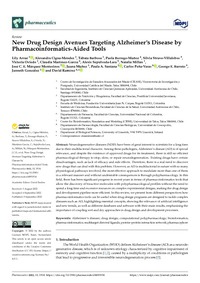Mostrar el registro sencillo de la publicación
New drug design avenues targeting alzheimer’s disease by pharmacoinformatics-aided tools
| dc.contributor.author | Arrué, Lily | |
| dc.contributor.author | Cigna-Méndez, Alexandra | |
| dc.contributor.author | Barbosa, Tábata | |
| dc.contributor.author | Borrego-Muñoz, Paola | |
| dc.contributor.author | Struve-Villalobos, Silvia | |
| dc.contributor.author | Oviedo, Victoria | |
| dc.contributor.author | Martínez-García, Claudia | |
| dc.contributor.author | Sepúlveda-Lara, Alexis | |
| dc.contributor.author | Millán, Natalia | |
| dc.contributor.author | Márquez Montesinos, José C. E | |
| dc.contributor.author | Muñoz, Juana | |
| dc.contributor.author | Santana, Paula A | |
| dc.contributor.author | Peña-Varas, Carlos | |
| dc.contributor.author | Barreto, George E | |
| dc.contributor.author | González, Janneth | |
| dc.contributor.author | Ramírez, David | |
| dc.contributor.author | Arrué | |
| dc.date.accessioned | 2022-10-24T13:35:16Z | |
| dc.date.available | 2022-10-24T13:35:16Z | |
| dc.date.issued | 2022 | |
| dc.identifier.uri | http://repositorio.ucm.cl/handle/ucm/4120 | |
| dc.description.abstract | Neurodegenerative diseases (NDD) have been of great interest to scientists for a long time due to their multifactorial character. Among these pathologies, Alzheimer’s disease (AD) is of special relevance, and despite the existence of approved drugs for its treatment, there is still no efficient pharmacological therapy to stop, slow, or repair neurodegeneration. Existing drugs have certain disadvantages, such as lack of efficacy and side effects. Therefore, there is a real need to discover new drugs that can deal with this problem. However, as AD is multifactorial in nature with so many physiological pathways involved, the most effective approach to modulate more than one of them in a relevant manner and without undesirable consequences is through polypharmacology. In this field, there has been significant progress in recent years in terms of pharmacoinformatics tools that allow the discovery of bioactive molecules with polypharmacological profiles without the need to spend a long time and excessive resources on complex experimental designs, making the drug design and development pipeline more efficient. In this review, we present from different perspectives how pharmacoinformatics tools can be useful when drug design programs are designed to tackle complex diseases such as AD, highlighting essential concepts, showing the relevance of artificial intelligence and new trends, as well as different databases and software with their main results, emphasizing the importance of coupling wet and dry approaches in drug design and development processes. | es_CL |
| dc.language.iso | en | es_CL |
| dc.rights | Atribución-NoComercial-SinDerivadas 3.0 Chile | * |
| dc.rights.uri | http://creativecommons.org/licenses/by-nc-nd/3.0/cl/ | * |
| dc.source | Pharmaceutics, 14(9), 1914 | es_CL |
| dc.subject | Alzheimer’s disease | es_CL |
| dc.subject | Drug design | es_CL |
| dc.subject | Computational polypharmacology | es_CL |
| dc.subject | Bioinformatics | es_CL |
| dc.subject | Pharmacoinformatics | es_CL |
| dc.subject | Multitarget directed ligands | es_CL |
| dc.subject | Protein–protein interaction network | es_CL |
| dc.subject | Pharmacophore | es_CL |
| dc.title | New drug design avenues targeting alzheimer’s disease by pharmacoinformatics-aided tools | es_CL |
| dc.type | Article | es_CL |
| dc.ucm.indexacion | Scopus | es_CL |
| dc.ucm.indexacion | Isi | es_CL |
| dc.ucm.doi | doi.org/10.3390/pharmaceutics14091914 | es_CL |



